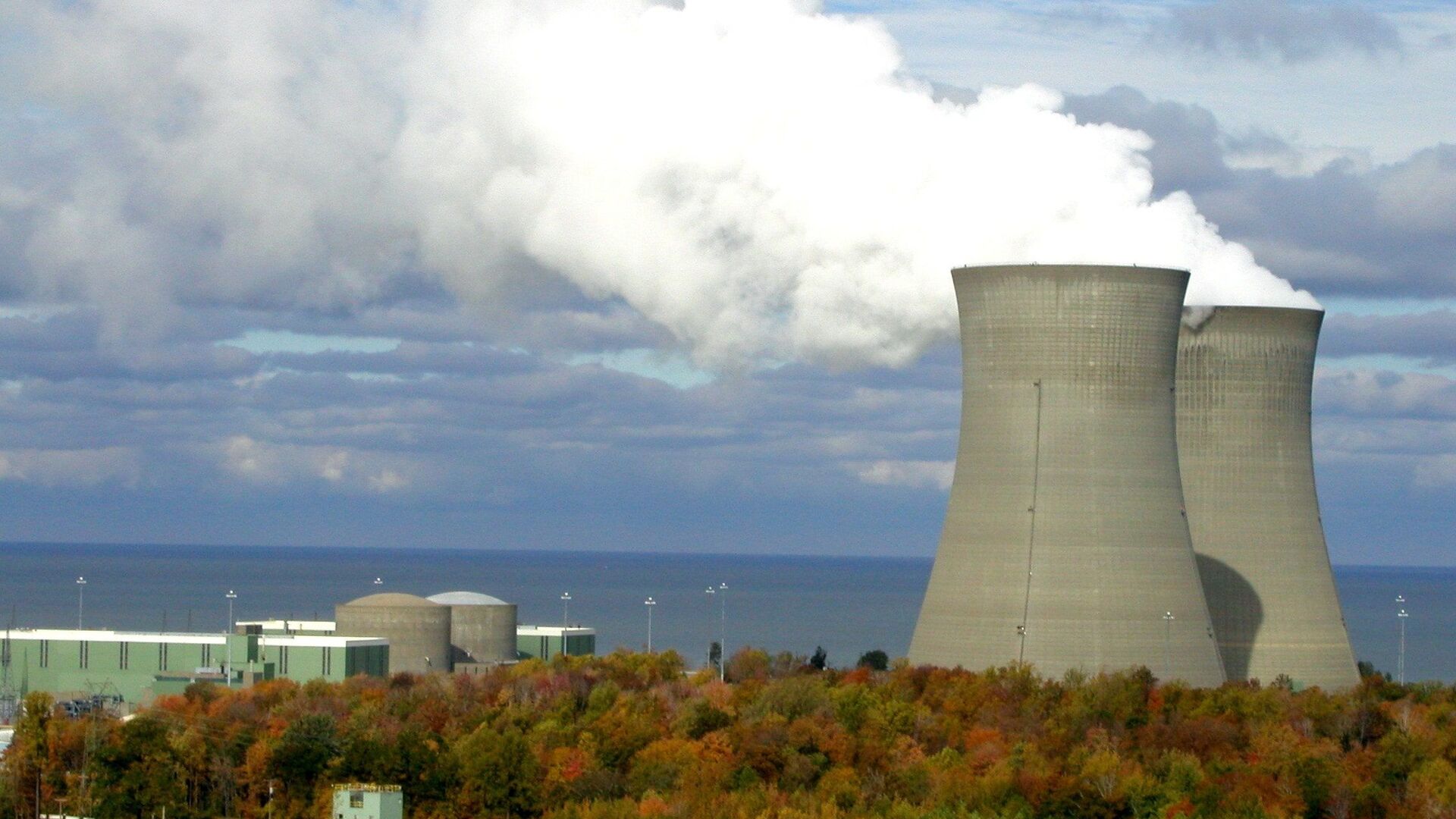https://sputnikglobe.com/20231107/us-acknowledges-critical-dependence-on-russian-nuclear-fuel-imports-1114801458.html
US Acknowledges 'Critical Dependence' on Russian Nuclear Fuel Imports
US Acknowledges 'Critical Dependence' on Russian Nuclear Fuel Imports
Sputnik International
As the US continues to push its decoupling from the economies of countries it considers adversaries, the next target is its imports of fuel for its nuclear power plants, some of which it purchases from Russia's Rosatom.
2023-11-07T19:06+0000
2023-11-07T19:06+0000
2023-11-07T19:06+0000
americas
rosatom
nuclear power plant
enriched uranium
imports
us
https://cdn1.img.sputnikglobe.com/img/07e4/0a/13/1080818035_0:117:2272:1395_1920x0_80_0_0_13087ee31b2fe56af2fefbc29c3ca9eb.jpg
American imports of enriched uranium from Rosatom doubled in the first half of 2023, reaching roughly one-quarter of the US’ nuclear fuel imports, despite Washington’s push to end purchases of Russian energy exports around the globe.Kathryn Huff, the US assistant secretary for nuclear energy, told a British newspaper on Tuesday that the US sourcing so much nuclear fuel from Russia was “gravely concerning.”“It’s really critical that we get off of our dependence, especially from Russia,” Huff said.A bill banning US imports from Rosatom by 2028 was approved by a House subcommittee in May, but has failed to make any progress in Congress since.Uranium naturally occurs in the soil, mostly in the form of U-238, but deposits also contain smaller amounts of U-235, a much more reactive isotope. Through a complex refining process, the U-235 is separated from the U-238 and concentrated, then formed into fuel rods that can be placed in nuclear reactors, where a nuclear reaction is induced to generate electricity. The same process, when extended to incredibly high levels of refinement, can also produce a form of uranium suitable for manufacturing a nuclear weapon.The US began buying large amounts of enriched uranium from Russia after the end of the Cold War under the Megatons to Megawatts program, which took 500 tons of Russian weapons-grade uranium once intended to be put in missiles aimed at American cities, and converted it into a form usable in American nuclear power plants.After the Fukushima Daiichi nuclear disaster in 2011, many nations paused nuclear power plant construction, which sent many private companies, such as Westinghouse and Areva SA, into bankruptcy, disrupting the supply chain. However, Russia’s state-owned Rosatom not only weathered the storm, but moved into those markets as the new enriched uranium supplier.Europe similarly gets large amounts of nuclear fuel from Russia - about 17% of its nuclear fuel imports last year - alongside much of its coal and liquified natural gas. As a result, sanctions on Russia have caused energy prices to spike in the European Union, driving businesses to flee and residents to protest.The US’ nuclear power sector is among the world’s largest, with a 29% global share in 2021, although it has been slowly decreasing since it peaked in the 1990s. In July, the US opened its first nuclear reactor in seven years at the Alvin W. Vogtle Electric Generating Plant in Georgia, bringing its total to 93 operating commercial reactors at 54 nuclear power plants, according to US Energy Information Agency statistics.
https://sputnikglobe.com/20231103/russian-nuclear-chief-praises-strategic-energy-security-partnership-with-belarus-1114701776.html
https://sputnikglobe.com/20231026/us-uranium-enrichment-capacity-years-behind-russias-1114505887.html
americas
Sputnik International
feedback@sputniknews.com
+74956456601
MIA „Rossiya Segodnya“
2023
News
en_EN
Sputnik International
feedback@sputniknews.com
+74956456601
MIA „Rossiya Segodnya“
Sputnik International
feedback@sputniknews.com
+74956456601
MIA „Rossiya Segodnya“
rosatom; enriched uranium; nuclear fuel; us imports, nuclear power plant, us imports nuclear fuel from russia, russian nuclear fuel for us
rosatom; enriched uranium; nuclear fuel; us imports, nuclear power plant, us imports nuclear fuel from russia, russian nuclear fuel for us
US Acknowledges 'Critical Dependence' on Russian Nuclear Fuel Imports
As the United States continues to push its decoupling from the economies of countries it considers adversaries, the next target is its imports of fuel for its nuclear power plants, some of which it purchases from the Russian state-owned corporation Rosatom.
American imports of enriched uranium from Rosatom
doubled in the first half of 2023, reaching roughly one-quarter of the US’ nuclear fuel imports, despite Washington’s push to end purchases of Russian energy exports around the globe.
Kathryn Huff, the US assistant secretary for nuclear energy, told a British newspaper on Tuesday that the US sourcing so much nuclear fuel from Russia was “gravely concerning.”
“It’s really critical that we get off of our dependence, especially from Russia,” Huff said.
“Without action Russia will continue to hold on to this market,' she added. "This is really important for national security, for climate, for our energy independence.”
A bill banning US imports from Rosatom by 2028 was approved by a House subcommittee in May, but has failed to make any progress in Congress since.

3 November 2023, 18:17 GMT
Uranium naturally occurs in the soil, mostly in the form of U-238, but
deposits also contain smaller amounts of U-235, a much more reactive isotope. Through a complex refining process, the U-235 is separated from the U-238 and concentrated, then formed into fuel rods that can be placed in nuclear reactors, where a nuclear reaction is induced to generate electricity. The same process, when extended to incredibly high levels of refinement, can also produce a form of uranium suitable for manufacturing a nuclear weapon.
The
US began buying large amounts of enriched uranium from Russia after the end of the Cold War under the
Megatons to Megawatts program, which took 500 tons of Russian weapons-grade uranium once intended to be put in missiles aimed at American cities, and converted it into a form usable in American nuclear power plants.
After the Fukushima Daiichi nuclear disaster in 2011, many nations paused nuclear power plant construction, which sent many private companies, such as Westinghouse and Areva SA, into bankruptcy, disrupting the supply chain. However, Russia’s state-owned Rosatom not only weathered the storm, but
moved into those markets as the new enriched uranium supplier.
The result is that today, the US lacks an adequate industry for mining, refining, and manufacturing U-235 nuclear fuel rods that’s able to meet the needs of its growing nuclear power sector, so it has turned to Rosatom to fill the gap. According to US government data, Rosatom supplied about 25% of its enriched uranium imports in the first half of 2023 and about 14% of nuclear fuel imports in 2022. It imports about 90% of its nuclear fuel, with other prominent customers being Kazakhstan, Uzbekistan, Canada, and Australia.

26 October 2023, 18:39 GMT
Europe similarly gets large amounts of nuclear fuel from Russia - about
17% of its nuclear fuel imports last year - alongside much of its coal and liquified natural gas. As a result, sanctions on Russia have caused
energy prices to spike in the European Union, driving businesses to flee and residents to protest.
The US’ nuclear power sector is among the world’s largest, with a 29% global share in 2021, although it has been slowly decreasing since it peaked in the 1990s. In July, the US opened its first nuclear reactor in seven years at the Alvin W. Vogtle Electric Generating Plant in Georgia, bringing its total to 93 operating commercial reactors at 54 nuclear power plants, according to US
Energy Information Agency statistics.




